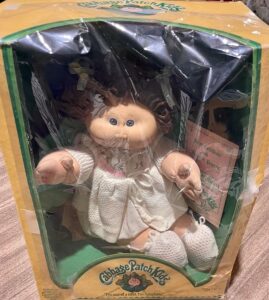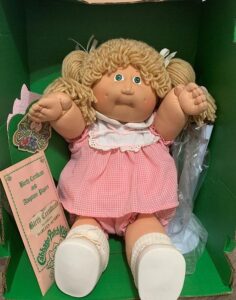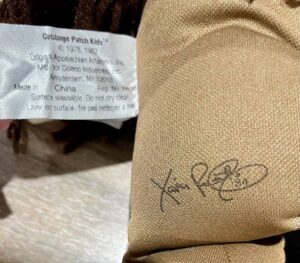
by Dr. Lori Verderame
In 1976, Xavier Roberts rediscovers the 19th Century German craft technique of needle molding to make textile sculptures that he sells at fairs and festivals. Roberts starts a big business at age 21 by capitalizing on the 1970s crafting craze and sells his original hand-made, one of a kind, dolls. At the time, the contemporary art movement known as Fiber Arts is all the rage in museums featuring major works of art by women artists like Judy Chicago, Miriam Schapiro and others. Crafting is big in the 1970s for the general public too. Xavier Roberts’ combined his interest in sculpture with the quilting skills that his mother passed down to him in order to create his first soft sculptures in the form of child dolls. These dolls became the highly collectible Cabbage Patch Kids.

The 1970s saw a rise in many types of needle crafts with each generation taking part in producing embroidered samplers, quilts, needlepoint pictures, crewel work pillows, etc. These crafts united the generations bringing children and grandparents together. This generational crossover is what brought success to the Cabbage Patch Kids dolls too. Purchased by grandparents and parents for children and grandchildren, Cabbage Patch Kids or Cabbage Patch dolls as they are also known are still valuable today. Unlike Beanie Babies toys, Cabbage Patch dolls were high priced to start which kept children trying to spend their allowance out of the market.
The 1970s debut of the Cabbage Patch Kids Dolls and their rise in popularity in the 1980s goes hand in hand with the changes in American culture at the time. An interest in business ventures, the stock market, entrepreneurship, as well as the significant changes in the structure of the nuclear family are all evident in the early 1980s. Divorce was becoming more commonplace and the Cabbage Patch dolls were giving children an opportunity to participate, through play, in the development of a family unit. Movies like Ordinary People and Kramer vs. Kramer commented on the breakdown of the traditional American family with a rising divorce rate.
Cabbage Patch dolls gave children a look into the adult decisions and responsibilities associated with raising children. This aspect of the Cabbage Patch doll –learning responsibility– was something that made parents and grandparents feel good about buying the high priced, one of a kind dolls, for their children. The $40 adoption fee for a Roberts-autographed Original Little People doll, the precursors to Cabbage Patch Kids, was pricey in the late 1970s. Roberts’ company, Original Appalachian Artworks, Inc., begin to produce Cabbage Patch Dolls based on the antique hand stitchery technique in large numbers to meet demand.
Simple American Lifestyle
In addition, Cabbage Patch Kids looked back to a simpler way of life—one associated with family values—away from the fast paced, money-driven lifestyle of the 1980s. The adoption papers that came with each Cabbage Patch Kids was an important part of the appeal of the dolls as children got important documentation, like a stock certificate, for this object that was to be protected and valuable. Today, values are higher for those Cabbage Patch dolls that have the original adoption papers and are housed in their original boxes from Coleco.
Like other popular toys, Cabbage Patch Kids won awards from the Toy Industry. Circa 1983, buying one of the ultra-popular dolls sparked long lines at toy and department stores like F.A.O. Schwartz, Sears, and J. C. Penney. In some instances, clamoring for Cabbage Patch dolls incited the then unheard of consumer riots which took place at stores carrying the popular playthings. An example of mass consumerism, the Cabbage Patch Kids represented a perfect storm for manufacturers and retailers as customers tried to buy the sought-after toys in a frenzy across America before they quickly sold out.

While Cabbage Patch Kids were focusing on infant and child dolls, other dolls were demonstrating what it was like to be an adult. One example is Mattel’s Barbie doll. Barbie, the fashion doll that was often featured as a professional, like a teacher or a stewardess, was a doll that allowed children to experience the working world. Conversely, away from the business world, Cabbage Patch Kids were encouraging children to act like parents. Cabbage Patch Kids focused on the wholesome values of family life instead of work life. They were the catalyst in some ways to the American Girl Dolls of the late 1980s which focused on children’s lives throughout historical periods.
With Cabbage Patch Kids, children could see themselves as parents instead of members of the American work force. Being defined for one’s role in a family was as important as one’s role in the workplace. These dolls, like the timely political statement of President George H. W. Bush, were prompting children to take a kinder, gentler view of American life. Years before George H. W. Bush said that he wanted “a kinder, gentler nation” at the GOP national convention in 1988, Cabbage Patch Kids were teaching kids that a hand stitched textile doll could bring harmony to families where there was emotional strife.
Children were interested in what adults were doing at home. Home life and family were going through a major cultural change during the 1980s. The topic of family planning was on the minds of many during this time. Women in the business world, complete with university degrees, briefcases, and sneakers for lunchtime exercise, chose to put childbearing on the back burner. Instead of having children in their 20s, many 1980s women were having children later than their 1970s counterparts. Women, in large numbers, were going to work as professionals in fields that were once only open to men.
In the 1980s, family planning was a hot topic. An even hotter topic was the topic of infertility. Infertility and the medical advances associated with it was an issue that was discussed and debated widely. The first successful birth from IVF took place in 1978 based on the research and experimentation of British physicians Robert Edwards and Patrick Steptoe. Louise Joy Brown was born in the summer of 1978. After, the first successful pregnancy resulting from the transfer of an embryo from one human to another was performed at Harbor-UCLA Medical Center in July 1983 and a resulting birth took place using this method in February of 1984.
While all of this was going on, of course, the topic of adoption was on the minds of those for whom IVF was not an option. And, it follows what is going on in the adult world will impact the world of children and spark new ideas for toys. Adopting a new doll was one of the results of this cultural phenomenon and Cabbage Patch Kids grew from this cultural conversation.
Cabbage Patch Kids Values
By the early 1980s, the Original Little People dolls, which were the precursors to Cabbage Patch Kids dolls, were being traded widely and already being viewed as coveted collectibles. Some of the early editions of the dolls from the late 1970s were commanding values into the thousands of dollars by 1981. Today, Cabbage Patch Kids dolls regularly command values into the hundreds to thousands of dollars depending on many factors including type, age of the doll, condition, clothing, packaging, etc.
By 1983, nearly three million Cabbage Patch Kids were sold. And the popularity of Cabbage Patch Kids dolls spread. In December of 1983, Cabbage Patch Kids were on the cover of Newsweek. In the years that followed, Cabbage Patch Kids gained a seat on the US Space Shuttle, were named the first official mascot of the 1992 US Olympic team during the Barcelona, Spain games, and Cabbage Patch Kids were featured on a postage stamp in 2000.
Values for vintage Cabbage Patch Kids dolls continue to command high prices with collectors. Attributes of Cabbage Patch Kids dolls helped drive the market and increase popularity and raise value. The hand made textile dolls were cute with stitched noses, chubby cheeks, and deep dimples but their names—mainly traditional names of the 19th and early 20th Century—attracted children and more recently collectors to them. Cabbage Patch Kids had sweet names like Yvonne Millie, Felicia Francis, Clayton Archibald and the like which added to their appeal. The uncommon yet traditional names for Cabbage Patch Kids dolls–from infant to toddler types–continued the tradition of naming a doll in order to drive business. Like Chatty Cathy, Chrissy and Velvet, Barbie and others, dolls with names were known products of the 1950s and beyond. This tradition may have helped Ty Warner decide to give cutesy names like Gobbles the Turkey, Fleece the Lamb, and Chocolate the Moose to his ultra-successful Beanie Babies stuffed toys.
What to Look For

When it comes to valuing Cabbage Patch Kids dolls, here are some tips on what to look for in order to command top dollar. The hand made Original Little People dolls that were first introduced by Xavier Roberts in the late 1970s are the most rare and collectible dolls associated with the Cabbage Patch Kids brand. These early dolls by Roberts command high values in the market online. Dolls like this that started such a massive trend make the Original Little People dolls so valuable. Many of them have an original autographed signature by Roberts on the buttocks of the dolls and are rare on the market. These early dolls sell into the thousands of dollars online and were modeled after actual people known to Xavier Roberts, the Cabbage Patch Kids toy company founder.
For value, Cabbage Patch Kids dolls have to be in good condition overall. Tags indicate where they were made such as Taiwan, China, etc. Like the dolls, another important thing that collectors of Cabbage Patch Kids look for is the doll’s original clothing or outfit in good condition. This means that the Cabbage Patch Kids’ clothes, shoes, and accessories like hair bows must be in good condition and intact with the doll in order to command top dollar on the resale market. Hair color including its style and length are important when valuing Cabbage Patch Kids dolls today. Also, facial characteristics like nose shape, freckles, and eye color of the dolls will have an impact on value. The autograph on the dolls are also something that collectors look for when it comes to Cabbage Patch Kids dolls. Cabbage Patch Kids dolls, originally based on antique crafting techniques of the 1800s, continue to command top dollar online today.
You know you’ve got a winner when others copy you. That’s exactly what happened to Cabbage Patch Kids. There were copycats galore. The copycat dolls in the tradition of Cabbage Patch Kids came onto the scene quickly such as The Original Doll Baby by Martha Nelson Thomas. The Original Doll Baby was a pre-sewn doll toy that children could sew and stuff. It came in a craft package with sewing needle, doll head, polyester stuffing, and a pre-sewn doll body. When finished, it looked remarkably like a Cabbage Patch Kids doll.
While the Original Little People dolls were popular, when the Cabbage Patch Kids dolls came onto the scene, it was the infants that were all the rage. During the heyday of the Cabbage Patch Kids doll craze, in the early 1980s, getting an infant Cabbage Patch Kids doll was an important “get” to a child of the 1980s. Children with the infant Cabbage Patch Kids dolls were the envy of their friends and this fueled the fire for Cabbage Patch Kids. It is possible that this interest in infants had some relationship to the ongoing cultural conversation about adoption at the time.
Other Cabbage Patch Kids that are collectible in the market are those dolls in their original boxes; always important for collectability. Many of the most valuable Cabbage Patch Kids dolls date to the early 1980s. Some of the most collectible Original Little People dolls are those that date from the late 1970s to the early 1980s. The Original Little People brand was renamed Cabbage Patch Kids and mass produced abroad in the early 1980s. Cabbage Patch Kids soon became an international sensation and today, collectors still look for these vintage dolls in the original packages with adoption papers, adoption envelope, storage box, and original clothing.
Watch videos on my YouTube channel where I talk more about Cabbage Patch Kids Dolls. I can appraise your dolls from photos or you can show me your dolls during a video call.


